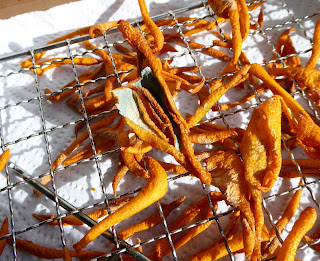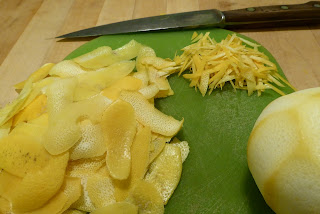Here in Sacramento, summer days can reach "a hundred and sh*t" degrees" as Mr. Dwayne so colorfully called it. We seldom use our oven during the summer months, but some summer fruits and veg demand that we shut the kitchen door and just turn it on. Think about it - pie, cobblers and crumbles are just a few of the reasons to risk a heat stroke. This dish is a savory reason to turn on your oven. Luckily, it will only be on for about 30 minutes and then you will have a yummy dinner to take to other, the more temperate, parts of your home.
One of the beautiful things about this dish is that it is really a method by which you can use nearly any set of flavors. In this example, I have used Indian flavors - chutney and yogurt marinate and veggies tossed in olive oil and a spicy curry powder seasoning. Look below for a list of flavor profiles that will serve you well.
I have used 4 boneless, skinless chicken thighs for this recipe. They cook perfectly in a 400 degree oven in 25 minutes. The summer vegetables I've used are cut into pieces about 1 x 1/2 inch square. These also cook to just tender-crisp in 25 minutes. You could also use this method with other cuts of meat or bone-in chicken, but it may take a bit longer and you will have to adjust the veggie size to compensate. I give you permission to experiment!
If you have not used parchment paper before, put it on your shopping list right now. Nothing sticks and clean up is easy-peasy. Mr. Dwayne appreciates this a lot! Another thing he appreciates is that, if you split this recipe down the middle, it is less than 500 calories for a plate full of yum.
Roasted Dinner - Indian Flavor
4 Boneless, skinless chicken thighs
1/4 cup plain yogurt
1 tbsp. coriander and garlic chutney
6 cups mixed veggies (summer squash, cherry tomatoes, 1/2 large sweet onion, 1 red bell pepper)
2 tbsp. olive oil
1/2 to 1 tsp. curry blend or garam masala
salt and pepper to taste (a couple of good grinds of each)
Combine the chicken, yogurt and chutney and massage it a bit to combine and completely coat the chicken. Let stand in the refrigerator 4 hours or over night. (Longer is better.)
When you are ready to cook, pre-heat the oven to 400 degrees and use the convection roast setting, if you have one.
Wash and dry the veg and cut up into pieces that will all cook in about the same amount of time - mine were all cut to just about match the size of the cherry tomatoes. Toss the veggies with the olive oil, curry powder and salt and pepper.
Line a baking sheet (one with a edge) with parchment paper. Place the chicken in a single layer down the middle of the baking sheet. Place half of the veggies on each side of the chicken. Roast in the pre-heated oven for 25 to 30 minutes, depending on the thickness of the chicken. What you see here was done in 25 minutes.
This serves 2 people at my house. Maybe 4 at yours.
Other Flavors:
Chicken Marinade Veggie Seasoning (Olive Oil + S&P)
Artichoke tapenade, lemon juice, Garlic & herb and Italian seasoning
Olive oil and garlic
Lime juice, cumin, ancho chile powder, Cumin, garlic and herb seasoning, squeeze of lime
garlic, olive oil, salt & pepper, a little sweetener
Teriyaki sauce + extra garlic and grated ginger Garlic & herb seasoning , 5 spice powder
Favorite vinaigrette with smoked paprika Garlic & herb seasoning and smoked paprika
Let me know if you think up any more!




















































